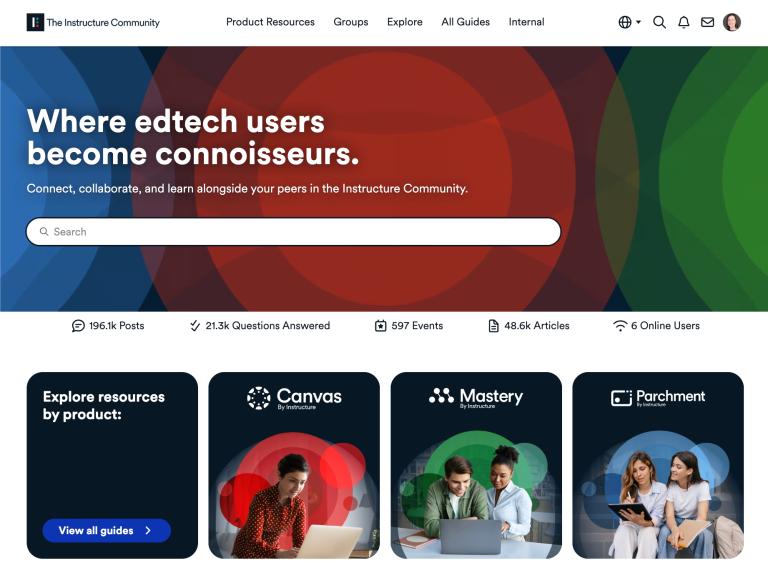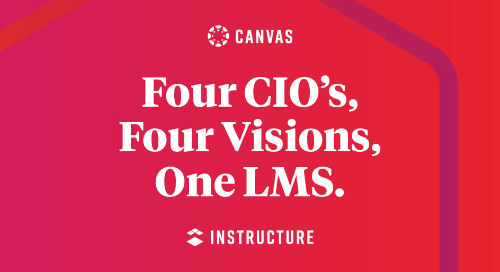In 2021, at Educause, Instructure brought together an off-campus panel of four CIO’s to speak about how their institution is navigating the new normal in higher ed. The panelists reflected on lessons learned in challenging times and how that translates into a future vision of teaching and learning centered around technology driving student success.
The four CIOs who shared their unique perspectives were:
- Dan Alig, CIO, The Wharton School
- Daren Hubbard, VP of IT and CIO, Georgia Institute of Technology
- Ben Rosebrock, Vice Chancellor of Information Technology, Alabama Community College System
- Dave Weil, Associate Vice President and CIO, Ithaca College
Ryan Lufkin, Sr. Director of Higher Education Product Marketing at Instructure, moderated the discussion and offered insights into how the panelist experiences mirrored Instructure’s findings in the 2021 State of Student Success and Engagement global trends report.
The panel focused on four key areas from the CIO perspective: training and supporting faculty, keeping students engaged and on track for successful careers, embracing transformative shifts brought on by COVID-19, and looking to the future.
Technology training and practices for faculty
For the Alabama Community College system, supporting educators is more of a challenge than at R1 institutions because the level of service is different. Alabama has stood up innovation centers to offer support across the state as a group. Making tech decisions and providing support in this way is more cost effective than going institution by institution.
At Wharton, Alig focuses on training for faculty no matter where they are in their career. “The tech ability to engage and support needs are fundamentally different depending on where a faculty member is in their career. We are able to meet people at any stage in their career and provide training.”
In addition to training, campuses are utilizing tools to create uniform experiences with an emphasis on digital accessibility for all courses. “The mobile app is creating a consistent course experience which positively impacts faculty and students,” said Weil.
Student-focus and preparation for the modern workforce
In the pandemic, focus and intention on making sure edtech tools work for their campuses was important, panelists said.
“The cloud-native aspect of Canvas and the ability of Canvas to integrate with other tool sets saved us time and energy because of the out of the box integration. We were able to school up 35+ integrations quickly in the pandemic. It’s the adaptability. There is nothing as adaptable as Canvas - everything just works. The ability to integrate into the workflow product has evolved in better and better ways,” said Hubbard.
These integrations increase student engagement and allow institutions to customize the student experience according to their student population’s needs. In addition to integrations, Canvas Catalog is helping schools serve credit and non-credit students across the community and the world.
“Catalog is helping us break the poverty cycle as we are competing with manual labor jobs and minimum wage jobs,” said Rosebrock, “Our goal is to change our state ranking in education and to do that we need skills-based programs.” GA Tech is also using Canvas Catalog for non-credit courses in the College of Professional Services.
“The global student population needed solutions to be able to participate. This unique challenge forced us to think differently. For our local student population struggling with internet access, we made laptop pickup in the food pantry, as that was the only area of campus that stayed open during the pandemic shut down. Our logic was, if you have one need, you will have another,” said Hubbard.
Ongoing transformational shift as an opportunity to evolve
Focusing on credit and non-credit students has helped institutions evolve and, “provide a base level service across the board,” with Canvas LMS and Canvas Catalog, said Rosebrock.
Institutions are, “harnessing the entrepreneurial spirit of some faculty,” to continue to use technology to support distance students and in-person courses alike through flipped classrooms, assessments, and student engagement tools like Canvas Studio.
At Ithaca, the 24/7 Canvas support for faculty and students has been a game-changer as well as the Canvas mobile app, which has reached a level of, “80-90% student adoption,” said Weil.
In addition to skills-based learning initiatives, adopting mobile apps across campus, and harnessing the skills of faculty, technology innovation will continue to evolve with student’s needs.
“Students are not able to unsee what they saw in the previous semesters during pandemic distance learning. Their expectations of tech and access to course materials is higher than ever before. There is a pressure from students to maintain the level of engagement from online learning now that hybrid and in-person learning is coming back,” said Hubbard.
“We are supposed to be here for students, their experience should be paramount. In the pandemic, flexibility and movement of students was easy - we will continue to evolve toward that model into the future to keep serving students where they are.”
What does the future look like
Across the panel it was unanimous that technology and a student-centered approach are at the heart of each CIO’s mission.
“Switching to Canvas has allowed us to focus on student outcomes. The entire (Canvas) tool is built around collecting data and making that data visible,” said Hubbard. This focus on data-informed decision making will be the future of higher education technology.
In Alabama, the community college system is back to pre-pandemic levels of registrations, partly thanks to a system-wide contract with Canvas Studio providing students high levels of engagement. “We love Studio, it has made a big difference,” Rosebrock said.
The pandemic was not the crisis that Wharton was preparing for, Alig said. Instead, “student debt and the rising cost of education,” was at the forefront of the institution's emergency planning. Now, improving efficiency and understanding how technology is at the center of institutional evolution.
“We use technology as a catalyst to support in-person learning and leverage tools to inform faculty, advisors, and students. By leveraging data and investing in the flow of data across the institution, we act in support of the student experience. We are in this business to improve the lives of people,” said Hubbard.
Thank you to the panelists for sharing their stories.
Learn more about how Canvas LMS is used by institutions around the world here.
Related Content
 inst-3step.jpg
inst-3step.jpgBlogs
 13lmsfeaturesthatbenefitstudentlearning.jpg
13lmsfeaturesthatbenefitstudentlearning.jpgBlogs
 community-homepage.jpg
community-homepage.jpgBlogs

